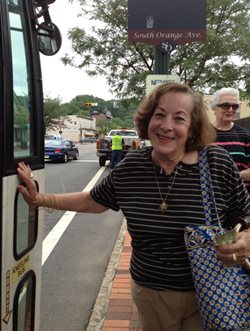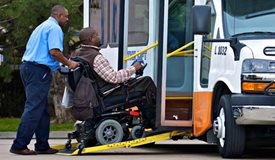Coordinated Public Transit Human Services Transportation

Human services transportation planning has a profound effect on the lives of the people it serves. The right systems, services, and policies can facilitate access to employment, education, social support, and personal independence. Lack of coordination, poor communication, and non-integrated service areas can leave passengers stranded, frustrated, and isolated.
A Coordinated Public Transit Human Services Transportation Plan (CPTHSTP) identifies the transportation needs of older adults (65+), low-income people, veterans, and individuals with disabilities and provides strategies for meeting these population’s needs.
The federal government recognized the importance of coordination of human service transportation over several rounds of major federal transportation legislation and most recently in the Fixing America’s Surface Transportation (FAST) Act. Transportation projects funded under Section 5310, which is designed to enhance the mobility of older adults (65+) and people with disabilities, must be identified through a local planning process that includes transportation providers (public, private and non-profit), human services providers, and members of the public. With this in mind, the NJTPA’s 2017 Regional CHSTP identifies the transportation needs of transportation-disadvantaged individuals in the region.
Transportation Management Associations (TMAs) are private, non-profit organizations established to work with employers and governments to help provide effective and efficient commuting and other transportation options. They also play an important role in planning for and improving Human Services Transportation (transportation for older adults, low-income people, veterans, and people with disabilities).
 NJTPA’s Coordinated Public Transit Human Services Transportation Plan
NJTPA’s Coordinated Public Transit Human Services Transportation Plan
The 2017 Regional Coordinated Human Services Transportation Plan (CHSTP) and 2023 update memo identify the transportation needs of older adults, low-income people, veterans, and individuals with disabilities within the NJTPA region. The regional 2017 plan was completed with consultant support from the Alan M. Voorhees Transportation Center at Rutgers University and data collection and public outreach support from the eight Transportation Management Associations serving New Jersey. The 2017 CHSTP includes an examination of existing plans, reports, laws, and regulations to inventory how and where services are provided to the transportation disadvantaged populations. In addition, data from various sources were analyzed to profile the travel patterns of the disadvantaged populations.
The plan provides strategies for meeting those needs and prioritizing transportation services for funding and implementation.
The 2023 plan update memo was prepared by NJTPA staff and updates the needs and recommendations of the 2017 Regional CHSTP, in consultation with service providers, community representatives, and agency partners. The plan update memo includes a demographic update of the human services populations, a stakeholder survey to capture whether the needs and recommendations documented in the 2017 regional plan are less, the same, or more relevant today, a focus group of human services transportation stakeholders comprised of transportation providers, human services providers, and veteran services providers, and re-prioritized needs and recommendations.
Findings
It is essential for those who provide human services transportation to understand the current needs of their service populations, the solutions to these problems, and what could be done now to provide accessible and equitable transportation for older adults, low-income persons, people with disabilities, and veterans. The CPTHSTP 2023 Update Memo culminates with a list of prioritized needs and recommendations. The Memo found that fare subsidies, driver training, performance, and retention, flexible services, accessibility, many-to-one, and one-to-may are the current top-rated needs in human services transportation.
Top 10 prioritized strategies:
- Reduced Fares for Older Adults and People with Disabilities
- Facilitate the Use of a Reduced Fare Program for Older Adults and Customers with Qualifying Disabilities
- Partnerships with Transportataion Network Companies (TNCs)
- Address Busy Signals and Excessive Wait Time for Phone Reservations
- Accessible TNC Vehicles
- Medical Trips - Subsidized TNC Rides
- Expand and Replicate Existing Non-Profit Car Services with Paid or Volunteer Drivers for Older Adults (65+) and People with Disabilities
- Universal Payment/Pre-Paid Fare Card
- Evaluate Routes and Services Based on Customer Needs
- Expand and Replicate Existing Cab Subsidy Programs for Older Adults
For more information about the definitions of the above needs and strategies, check out the 2023 CPTHSTP Update Memo and 2017 Regional CHSTP.
Coordinated Public Transportation Human Services Transportation Plan Video
For questions regarding CPTHSTP efforts, please contact:
Jasmine Grossmann
Principal Planner, TMA & Mobility Programs
[email protected] | 973-639-8440